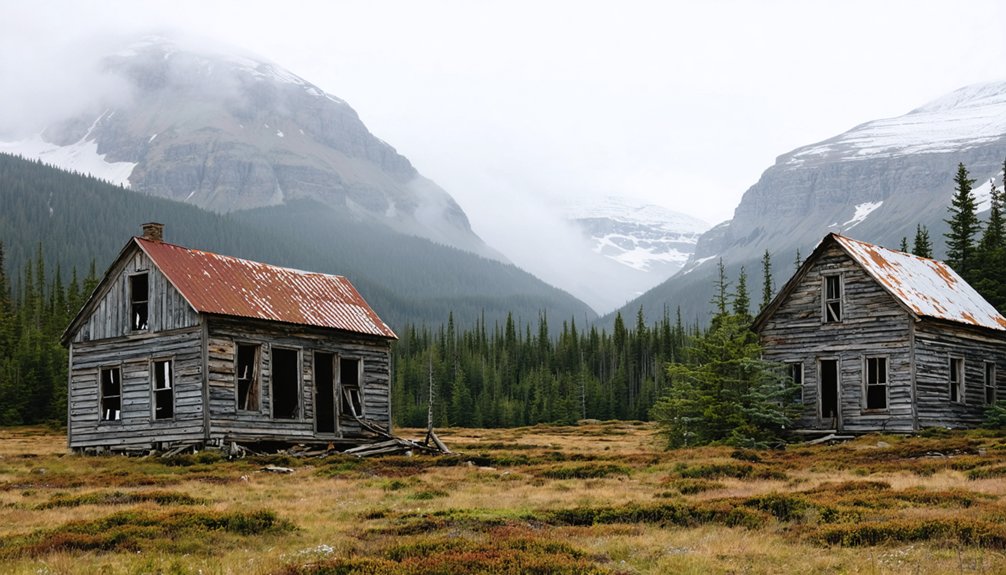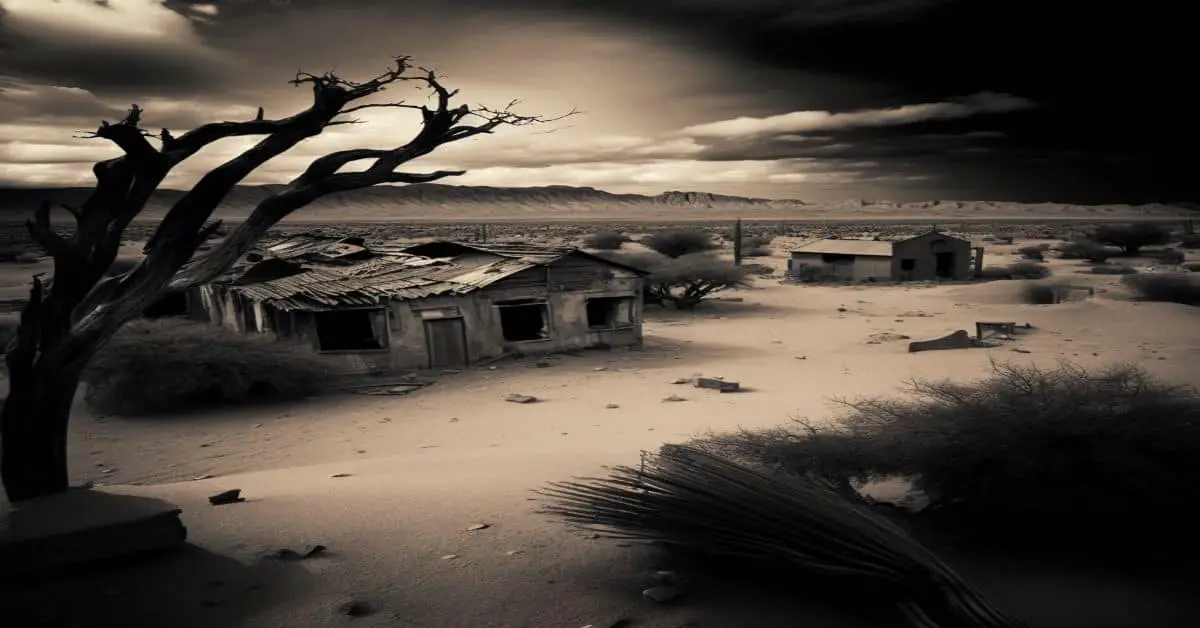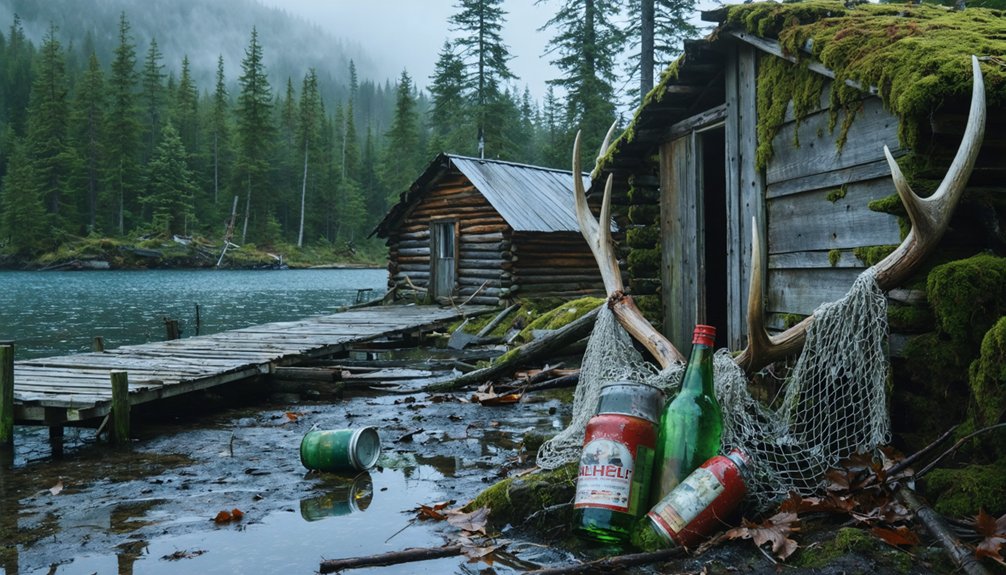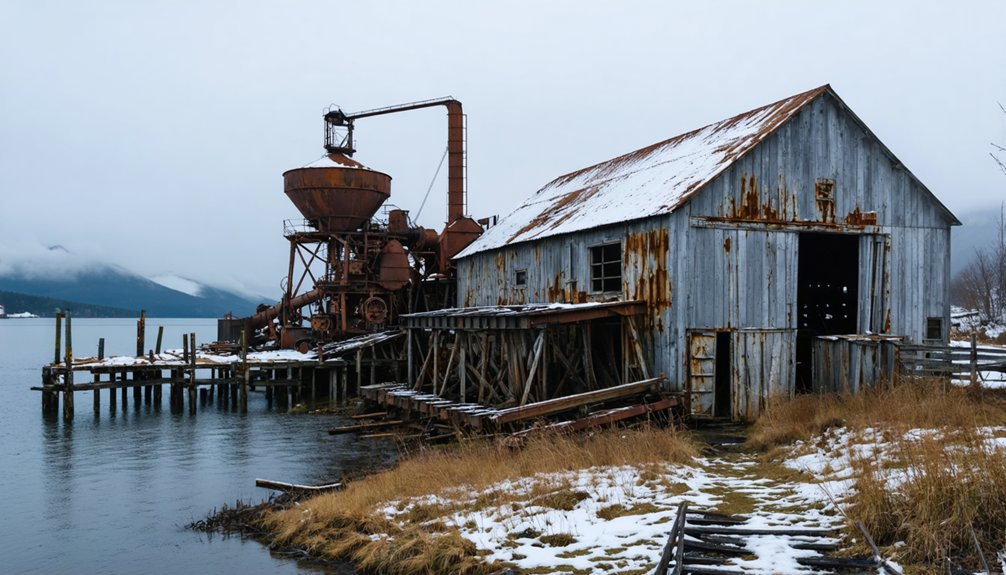You’ll find the ghost town of Ukivok clinging to King Island’s steep cliffs, 86 miles northwest of Nome, Alaska. This remarkable indigenous settlement showcases the Ugiuvaŋmiut people’s engineering prowess through their ingenious stilt houses built on 45-degree slopes. The village, constructed from driftwood and walrus hide, was home to skilled hunters and ivory carvers until 1970. The abandoned structures that remain tell a compelling story of adaptation, survival, and ultimate displacement.
Key Takeaways
- Ukivok village on King Island was abandoned around 1970 when the last residents were forced to relocate to mainland Alaska.
- The ghost town features unique stilt houses built on 45-degree cliffs, showcasing remarkable indigenous architectural innovation.
- Remnants include abandoned homes, a Bureau of Indian Affairs school, and a Catholic church built during the 1929 expansion.
- The village structures were ingeniously constructed using driftwood, local stone, and walrus hide to withstand harsh Arctic conditions.
- The abandoned settlement represents the former home of the Ugiuvaŋmiut people, who lived seasonally between King Island and Nome.
The Remarkable Geography of King Island
Rising dramatically from the Bering Sea, King Island stands as a remote geological sentinel approximately 86 miles northwest of Nome, Alaska. This imposing landmass, stretching 1.7 miles long and 1.4 miles wide, features steep, rocky cliffs that rise to a distinctive double-peaked summit reaching 1,050 feet above sea level.
You’ll find the island’s geological significance in its biotite-hornblende quartz monzonite composition, formed through plutonic intrusion during the Late Cretaceous period. The rugged terrain, marked by slippery algae-covered boulders and near-vertical cliffs, creates challenging conditions for both human access and ecological diversity. The island’s granite composition makes it one of several resistant plutonic formations that have withstood extensive erosion in the Bering Sea region. Traditional Ugiuvaŋmiut hunters skillfully navigated these treacherous cliffs while hunting seals and walruses.
As part of the Alaska Maritime National Wildlife Refuge, the island’s harsh environment, shaped by frequent storms and Arctic conditions, provides a unique habitat for seabirds while bearing witness to ongoing climate-driven changes in the region.
Life Among the Cliffs: The Ugiuvaŋmiut People
The stark cliffs and harsh environment of King Island provided an unlikely yet ingenious home for the Ugiuvaŋmiut, an Inupiat group who mastered living in one of Earth’s most challenging locations.
You’ll find their remarkable dwellings attached to the rocky cliffs, with walrus-skin covers stretched over wooden frames protecting inhabitants from fierce maritime weather.
The Ugiuvaŋmiut culture thrived through a perfect balance of winter traditions and seasonal migrations. Captain James Cook first encountered the island in 1778 and named it after Lieutenant James King.
During the cold months, up to 200 residents gathered in the Qagri for drumming and dancing, while hunters pursued seals and walruses. They’d preserve their catch in the natural cold storage cave called Qaitquq.
Come summer, they’d navigate to Nome by qayaq and umiak, where they’d hunt caribou, fish for salmon, and trade their renowned ivory carvings. In 1929, the community expanded with the addition of BIA school facilities and a Catholic church.
Engineering Marvel: Stilt Houses on Rocky Slopes
Among the most remarkable architectural innovations of Alaska’s Indigenous peoples, King Island’s stilt houses demonstrate masterful engineering that emerged during the 19th century.
You’ll find these structures perched on rocky cliffs, where the Iñupiat people developed an ingenious stilt house construction method using driftwood and local materials.
The architectural resilience of these homes stems from their adaptive design features. Wooden frames, secured with stretched walrus hide, withstand brutal Arctic conditions while providing stable living spaces on the precipitous terrain. Like modern security systems that use proof of work to protect against threats, these homes were designed with multiple defensive features against harsh environmental forces.
As steel tools became available through contact with whalers and missionaries, the Ugiuvamiut refined their building techniques. Today, digital collections help preserve the history and engineering knowledge of these remarkable structures.
These engineering marvels showcase how Indigenous innovation transformed limited resources into lasting settlements, creating multi-level dwellings that supported their community’s cultural and economic activities despite the harsh environment.
Seasonal Rhythms and Traditional Practices
Life on King Island followed intricate seasonal rhythms, with the Iñupiat people’s survival depending on precise timing of hunts and harvests throughout the year.
You’d find them tracking walrus migrations when the animals turned pink before hauling onto sea ice, while meticulously setting seal nets required round-the-clock community vigilance.
The seasonal hunting patterns reflected deep ecological knowledge passed down through generations. Their craftsmanship included creating watertight parkas from walrus parts to survive the harsh winters.
You’ll notice how traditional practices intertwined with daily life – from women observing specific customs during seal hunting to the community’s efficient use of every animal part.
They’d preserve meat and seal oil for the long winters, while summer brought migrations to the mainland for fishing and trading.
Their cultural traditions adapted to nature’s cycles, though modern climate change has disrupted these time-honored patterns. Living in walrus skin dwellings perched on steep cliffs, they maintained a remarkable connection to their environment.
The Devastating Impact of Commercial Whaling
By the mid-19th century, you’ll find that commercial whalers had decimated the walrus population in the Bering Sea through intensive hunting practices focused on ivory and oil extraction.
The catastrophic decline of walruses, a critical food source for King Island’s Ugiuvaŋmiut people, triggered a devastating food crisis that resulted in over 200 deaths from starvation in 1890. These hunting operations were conducted with similar intensity to the Yankee whaling fleets that had invaded the North Pacific waters in the 1830s.
You can trace how this ecological devastation forced the surviving Ugiuvaŋmiut to abandon their traditional subsistence patterns, fundamentally disrupting their community’s food security and cultural practices. The Ugiuvaŋmiut people eventually established new economic practices through walrus ivory carving trade with Nome.
Walrus Population Near Extinction
When commercial whaling operations intensified in the mid-20th century, Pacific walrus populations faced a catastrophic decline that nearly drove them to extinction.
You’ll find that Soviet and other commercial fleets removed vast numbers of breeding adults, particularly devastating the reproductive capacity of these marine mammals.
Despite this crisis, walrus conservation efforts have yielded remarkable results.
Population recovery began about 25 years after exploitation ended, with numbers rising from 90,000 in 1963 to approximately 257,000 by 2017.
However, you’ll notice the recovery hasn’t been straightforward.
The population continues to face challenges, including male-biased hunting, reduced reproductive success, and high calf mortality.
The species’ slow reproductive rate – with 15-month gestation periods and calves dependent on mothers for two years – makes population rebounds particularly challenging.
Native Community Food Crisis
The devastating impact of commercial whaling extended far beyond marine ecosystems, triggering a severe food crisis among Alaska’s native communities in the mid-20th century.
You’ll find that the struggle for food sovereignty became particularly acute as commercial operations depleted whale populations that indigenous peoples had sustainably harvested for generations.
- Subsistence whaling served as a cornerstone of cultural preservation and survival
- Remote locations made store-bought food prohibitively expensive
- Traditional hunting knowledge proved essential for community sustenance
- Limited employment opportunities increased reliance on traditional food sources
- The Alaska Native Claims Settlement Act complicated traditional practices
The crisis highlighted the delicate balance between cultural traditions and modern challenges, as communities fought to maintain their way of life while adapting to changing economic realities.
Their struggle exemplified the broader battle for indigenous rights and food security in Alaska’s remote regions.
The Silent Village: What Remains Today
Standing in defiance of time and weather, Ukivok village remains a haunting tribute to indigenous ingenuity on King Island’s steep southern slope.
If you visit today, you’ll find abandoned structures perched precariously on wooden stilts, evidence of the remarkable adaptation of the Ukivokmiut people to this challenging terrain.
The cultural remnants tell a story of resilience – houses built from stone, driftwood, and walrus hide still cling to the 45-degree incline.
The school and church buildings, though weathered, continue to stand against the harsh Bering Sea elements.
While the last residents departed around 1970, leaving behind their vertical village due to forced mainland relocation, the physical evidence of their remarkable architectural achievements endures, preserving the memory of this unique indigenous settlement.
Frequently Asked Questions
Are There Any Plans to Restore or Preserve the Remaining Structures?
You won’t find any active restoration efforts for these structures, despite community interest. The site’s remote location and harsh environment create significant preservation challenges that currently outweigh formal preservation attempts.
What Traditional Games and Sports Did King Island Children Play?
You’ll find children playing one-foot high kicks, seal hops, kneel jumps, and stick pull games – traditional games that built essential survival skills while fostering community bonds through friendly competition.
How Did Residents Handle Medical Emergencies on the Remote Island?
You’d rely on traditional healers, shared medical supplies, and community support for emergencies. When possible, you’d evacuate via Coast Guard vessels or seasonal trips to Nome for serious cases requiring treatment.
What Traditional Ceremonies Marked Important Life Events on King Island?
You’d have experienced ceremonial dances during births, marriages, and deaths, though specifics remain unclear. Life celebrations included the Messenger Feast, where communities gathered to share food and cultural traditions.
Did Any Non-Indigenous People Ever Permanently Settle on King Island?
No, non-indigenous people didn’t permanently settle there. You’ll find settler impact was limited to temporary institutional roles like teachers and officials, while cultural exchange occurred mainly through brief mainland interactions.
References
- https://www.alaska-stories.com/p/the-fascinating-surprising-king-island
- https://www.islands.com/1931925/king-island-ukivok-alaska-forgotten-coastal-village-stilts-remote-wonder-stories-vanished-era/
- https://en.wikipedia.org/wiki/King_Island_(Alaska)
- https://www.abandonedspaces.com/uncategorized/king-island-alaska-lost-home-inupiat-ice-fishermen.html
- https://www.thearcticinstitute.org/climate-change-migration-cultures-alaska-foreboding-ghost-village/
- https://coastview.org/2025/08/11/king-island-village-bering-sea/
- https://www.messynessychic.com/2016/11/01/alaskas-eskimo-ghost-village-on-stilts/
- https://coastview.org/2024/12/12/king-island-bering-sea/
- https://www.hcn.org/articles/north-communities-dwindling-sea-ice-and-rising-arctic-ship-traffic-may-bring-unwelcome-visitors-to-king-island-alaska/
- https://kids.kiddle.co/King_Island_(Alaska)



